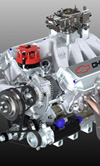Heart health
 The oil pump in any engine has been likened to the human heart. At the core of operations it provides the essential life-giving fluid to all the other components and surfaces in the system. And while there are many other similarities, unlike the human heart, the oil pump seems to be accepted as some form of necessity but given very little attention thereafter.
The oil pump in any engine has been likened to the human heart. At the core of operations it provides the essential life-giving fluid to all the other components and surfaces in the system. And while there are many other similarities, unlike the human heart, the oil pump seems to be accepted as some form of necessity but given very little attention thereafter.
In part I guess this attitude stems from our road-going transport habits. Buried away deep inside the power unit and out of sight, the only time we might ever think
about it is when that little red light on the dashboard starts flashing or, in some more modern cars (where this light is omitted), strange grinding–type noises start emanating from under the bonnet. For our racer, to be fair, we do think about these things but so long as the oil tank is topped up and the oil pressure gauge shows ample oil pressure, do we really care or even want to know more?
When used for serious competition, most engine oil systems used would now be classed as ‘dry sump’. This means that the oil pump not only has to supply the oil to the engine bearings, pistons and cams but also has to scavenge that same oil out of the engine afterwards. In this way, or so the theory goes, we can reduce the depth of the oil pan (and hence lower the position of the engine in the car) and totally eliminate the oil pressure surge issues associated with high ‘G’ cornering and braking. But getting the oil out of the engine isn’t always the easiest of chores. To start off with, it is far from 100% oil. Sprayed all round the engine crankcase and camshaft chest and mixed with copious amounts of air by the endless churning of the reciprocating and rotating parts, the resulting cocktail can look more like a dirty brown blancmange than the best quality synthetic you poured in. Getting this out of the engine at the bottom therefore requires multiple scavenge pumps which will then need to direct the mixture into some form of ‘swirl’ pot to de-aerate it prior to it going back into the pressure pump and hence onto the engine again. As a very minimum most designers will recommend that the scavenge pump(s) should have at least twice the capacity of the pressure pump and in some cases sometimes as much as four times, depending upon the engine and its oiling characteristics. Since dry sump pump systems are modular there are therefore no excuses for having insufficient scavenge performance available. The reduction in crankcase pressure and improved windage losses could also give other, more tangible benefits.
In a ‘wet sump’ engine, all this is removed from view and tucked well away when this air-oil mixture in the crankcase will slide down the gently sloping shelf forming the base of the sump, and from thence into the well. This process delays the oil sufficiently as it drains back and enables it to release much of the entrained air, and without us even having to think about it. As a young and inexperienced engineer I remember once, many years ago I hasten to add, trying to get the oil out of a prototype engine. This particular research engine although having an integral sump was intended to have only external oil and water pumps and without the budget for a proper scavenge system it wasn’t long before we had all manner of oil/air mixtures coming out of each and every orifice on the engine as well as some we didn’t even know about! In the end we managed to remove the oil from the engine and de-aerate it using other means but needless to say, if ever a lesson was well learned, that was it.
At least one engine builder of repute has been known to run an engine without a sump just to find out what is happening in the crankcase. It may sound bizarre but the lessons he learned will be most surely worth it.
So, design your oil system carefully. Look after it as you would your own heart and may you have a long and fruitful life together.
Written by John Coxon.